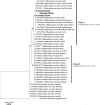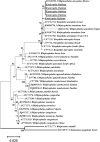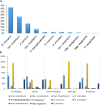Seasonal Dynamics, Record of Ticks Infesting Humans, Wild and Domestic Animals and Molecular Phylogeny of Rhipicephalus microplus in Khyber Pakhtunkhwa Pakistan
- PMID: 31379587
- PMCID: PMC6646419
- DOI: 10.3389/fphys.2019.00793
Seasonal Dynamics, Record of Ticks Infesting Humans, Wild and Domestic Animals and Molecular Phylogeny of Rhipicephalus microplus in Khyber Pakhtunkhwa Pakistan
Abstract
Although ticks prevalent in various agro-systems of Pakistan are associated with economic losses, information is still missing about the tick's diversity, hosts they infest, seasonal dynamics and molecular phylogeny of Rhipicephalus microplus in Khyber Pakhtunkhwa (KP) Pakistan. This study for the first time enlisted ticks infesting diverse hosts including humans in various regions of KP. A total of 8,641 ticks were collected across the northern, southern and central regions of KP and were morpho-taxonomically categorized into six genera comprising 17 species, R. microplus (n = 3,584, 42%), Hyalomma anatolicum (n = 2,253, 27%), Argas persicus (n = 1,342, 16%), Hya. impeltatum (n = 586, 7%), R. turanicus (n = 161, 2%), R. haemaphysaloides (n = 142, 2%), R. annulatus (n = 132, 2%), Hae. montgomeryi (n = 123, 1.4%), Hya. marginatum (n = 110, 1.3%), R. sanguineus (n = 34, 0.4%), and Hae. longicornis (n = 31, 0.4%). Ticks infesting wild animals included Amblyomma gervaisi, Amb. exornatum, Amb. latum, Dermacentor marginatus, and Hae. indica, while ticks collected from humans included R. microplus, R. annulatus, Hya. anatolicum, Hya. marginatum, and Hae. punctata. The overall prevalence of ticks infesting domestic animals was 69.4% (536/772). Among animal hosts, cattle were found highly infested (87.2%, 157/180) followed by buffalos (79%, 91/114), domestic fowls (74.7%, 112/150), goats (68.3%, 82/120), dogs (66.7%, 32/48), horses (61.3%, 49/80), and sheep (16.3%, 13/80). Analysis revealed that the tick burden significantly differed among domestic animals and was found to be high in cattle, followed by buffalos, goats, sheep, domestic fowl, dogs, and horses. Seasonal patterns of ticks distribution showed highest prevalance in July, August, and September due to the prevailing high temperature and humidity during these months. The phylogenetic analysis of cattle tick R. microplus based on partial mitochondrial cytochrome oxidase subunit I (COX1), 16S ribosomal RNA (16S rRNA) and internal transcribed spacer 2 (ITS2) sequences, revealed that R. microplus prevalent in this region belongs to clade C which include ticks originating from Bangladesh, Malaysia, and India. Further large scale studies across the country are necessary to explore the molecular and cross breeding aspects at the geographical overlapping of various tick species and their associated pathogens to facilitate designing control strategies as well as awareness against tick infestation in the region.
Keywords: Khyber Pakhtunkhwa; Pakistan; R. microplus; hosts; ticks.
Figures








Similar articles
-
A cross-sectional survey of hard ticks and molecular characterization of Rhipicephalus microplus parasitizing domestic animals of Khyber Pakhtunkhwa, Pakistan.PLoS One. 2021 Aug 5;16(8):e0255138. doi: 10.1371/journal.pone.0255138. eCollection 2021. PLoS One. 2021. PMID: 34351948 Free PMC article.
-
Epidemiologic profile of hard ticks and molecular characterization of Rhipicephalus microplus infesting cattle in central part of Khyber Pakhtunkhwa, Pakistan.Parasitol Res. 2022 Sep;121(9):2481-2493. doi: 10.1007/s00436-022-07596-3. Epub 2022 Jul 15. Parasitol Res. 2022. PMID: 35838795
-
Ticks Infesting Dogs in Khyber Pakhtunkhwa, Pakistan: Detailed Epidemiological and Molecular Report.Pathogens. 2023 Jan 6;12(1):98. doi: 10.3390/pathogens12010098. Pathogens. 2023. PMID: 36678446 Free PMC article.
-
Distribution and ecology of ticks (Acari: Ixodidae) infesting livestock in Tunisia: an overview of eighth years field collections.Parassitologia. 1999 Sep;41 Suppl 1:5-10. Parassitologia. 1999. PMID: 11071534 Review.
-
Genetic Diversity of Rhipicephalus (Boophilus) microplus for a Global Scenario: A Comprehensive Review.Pathogens. 2024 Jun 18;13(6):516. doi: 10.3390/pathogens13060516. Pathogens. 2024. PMID: 38921813 Free PMC article. Review.
Cited by
-
Molecular detection of Anaplasma bovis, Candidatus Anaplasma boleense and Rickettsia spp. in ticks infesting small ruminants.BMC Vet Res. 2024 Sep 11;20(1):408. doi: 10.1186/s12917-024-04259-6. BMC Vet Res. 2024. PMID: 39261829 Free PMC article.
-
Diversity of Rickettsiales in Rhipicephalus microplus Ticks Collected in Domestic Ruminants in Guizhou Province, China.Pathogens. 2022 Sep 27;11(10):1108. doi: 10.3390/pathogens11101108. Pathogens. 2022. PMID: 36297165 Free PMC article.
-
Ornithodoros (Pavlovskyella) ticks associated with a Rickettsia sp. in Pakistan.Parasit Vectors. 2022 Apr 21;15(1):138. doi: 10.1186/s13071-022-05248-0. Parasit Vectors. 2022. PMID: 35449077 Free PMC article.
-
Prevalence and Distribution of Hard Ticks and Their Associated Risk Factors in Sheep and Goats from Four Agro-Climatic Zones of Khyber Pakhtunkhwa (KPK), Pakistan.Int J Environ Res Public Health. 2022 Sep 17;19(18):11759. doi: 10.3390/ijerph191811759. Int J Environ Res Public Health. 2022. PMID: 36142032 Free PMC article.
-
Vector-borne pathogens in dogs of different regions of Iran and Pakistan.Parasitol Res. 2021 Dec;120(12):4219-4228. doi: 10.1007/s00436-020-06992-x. Epub 2021 Jan 28. Parasitol Res. 2021. PMID: 33506332 Free PMC article.
References
-
- Ali A., Parizi L. F., Ferreira B. R., Junior V., da Silva I. (2016). A revision of two distinct species of Rhipicephalus: R. microplus and R. australis. Cienc. Rural 46 1240–1248.
-
- Apanaskevich D. A., Horak I. G. (2005). The genus Hyalomma. II The taxonomic status of H. (Euhyalomma) anatolicum Koch 1844 and H. (Euhyalomma) excavatum Koch 1844 with the redescription of all stages. Acarina 13 181–197.
-
- Apanaskevich D. A., Horak I. G. (2008). The genus Hyalomma Koch, 1844: V. Re-evaluation of the taxonomic rank of taxa comprising the H. (Euhyalomma) marginatum Koch complex of species (Acari: Ixodidae) with redescription of all parasitic stages and notes on biology. Int. J. Acarol. 34 13–42. 10.1080/01647950808683704 - DOI
-
- Apanaskevich D. A., Horak I. G. (2009). The genus Hyalomma Koch, 1844. IX. Redescription of all parasitic stages of H. (Euhyalomma) impeltatum Schulze & Schlottke, 1930 and H. (E.) somalicum Tonelli Rondelli, 1935 (Acari: Ixodidae). Syst. Parasitol. 73 199–218. 10.1007/s11230-009-9190-x - DOI - PubMed
LinkOut - more resources
Full Text Sources

